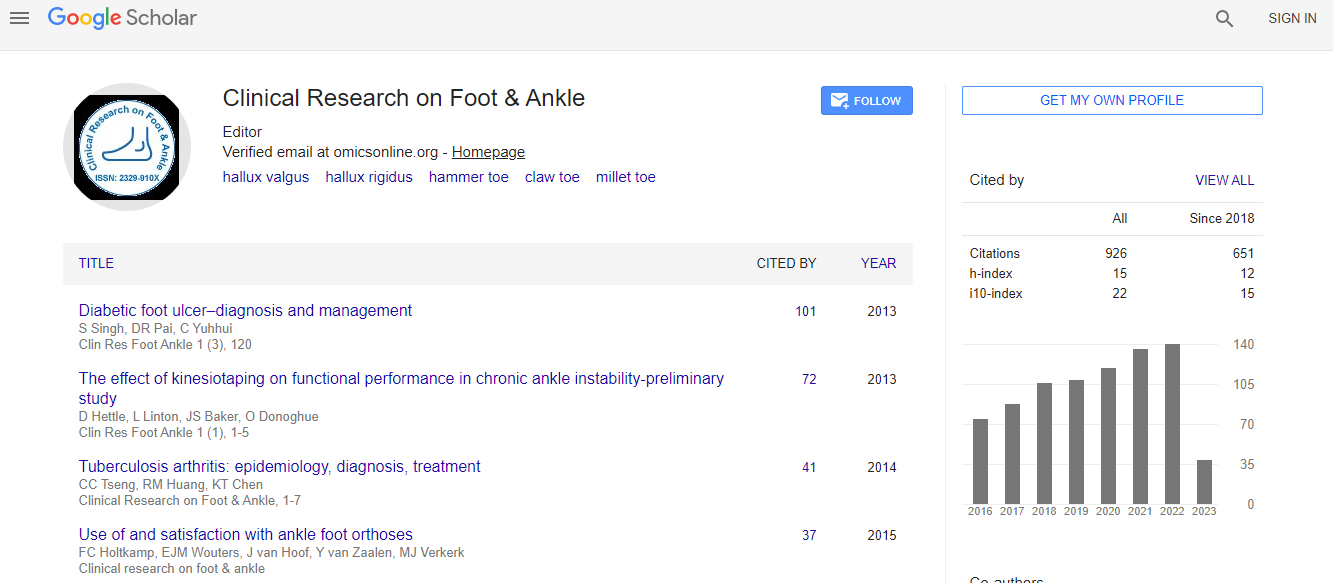Case Report
Both Ankles Severe Postburn Edge Dorsiflexion Contracture in Pediatric Patient: Anatomy and Treatment with Trapeze-Flap Plasty-A Case Report and Literature Review
Viktor M Grishkevich*Department of Reconstructive and Plastic Surgery, AV Vishnevsky Institute of Surgery of the Russian Academy of Medical Sciences, Moscow, Russia
- *Corresponding Author:
- Viktor M Grishkevich
Department of Reconstructive and Plastic Surgery
A.V. Vishnevsky Institute of Surgery of the Russian
Academy of Medical Sciences, Moscow, Russia
Tel: 503-698-1195
E-mail: grishkevichmail@gmail.com
Received Date: April 26, 2013; Accepted Date: June 24, 2013; Published Date: June 28, 2013
Citation: Grishkevich VM (2013) Both Ankles Severe Postburn Edge Dorsiflexion Contracture in Pediatric Patient: Anatomy and Treatment with Trapeze-Flap Plasty-A Case Report and Literature Review. Clin Res Foot Ankle 1:112. doi: 10.4172/2329-910X.1000112
Copyright: © 2013 Grishkevich VM. This is an open-access article distributed under the terms of the Creative Commons Attribution License, which permits unrestricted use, distribution, and reproduction in any medium, provided the original author and source are credited.
Abstract
Postburn severe edge ankle dorsiflexion contractures are the result of deep burn of the lateral joint surface. The contracture affects the foot motions, impairs the lower extremity function and slows down its development in pediatric patients; scars and tissue defects cause severe deformities. Therefore, early reconstruction is needed. Review of literature shows that ankle scar contractures are the least researched among big joints contractures when it comes to surgical treatment, and little attention is given to this problem. The most common curative technique is a contracture release with contracted scar incision and skin grafting (1). Rarely distally based sural or free flaps are used (2). Severe ankle contractures are treated using Ilizarov fixator. (3). The rate of contracture recurrence is high (see Discussion). It is no clear why local tissues (scars and healthy skin) cannot be used for ankle contracture treatment.
There is no anatomic classification of the ankle scar contractures. Our experience (personally operated 55 patients with ankle scar contractures) allowed us to divide all dorsiflexion scar contractures into three types and propose appropriate surgical local-flap techniques for each type (4). It was also noted that mild and moderate edge and medial dorsiflexion contractures can be successfully eliminated with trapeze-flap plasty using local adiposecutaneous and adipose-scar trapezoid flaps. New approach allowed escape skin grafts and regional pedicled flaps. Previous publications did not cover the severe ankle dorsiflexion contracture. In this paper we add to research and literature by analyzing the anatomy and treatment of one child, 5-years of age, with severe both ankles edge contractures. The paper aims to demonstrate that the trapeze-flap plasty in combination with skin grafting are able to solve a very complex problem and achieve excellent functional and good cosmetic outcomes.

 Spanish
Spanish  Chinese
Chinese  Russian
Russian  German
German  French
French  Japanese
Japanese  Portuguese
Portuguese  Hindi
Hindi 
